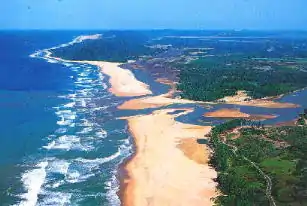Paradox of the plankton
In aquatic biology, the paradox of the plankton describes the situation in which a limited range of resources supports an unexpectedly wide range of plankton species, apparently flouting the competitive exclusion principle which holds that when two species compete for the same resource, one will be driven to extinction.

Ecological paradox
The paradox of the plankton results from the clash between the observed diversity of plankton and the competitive exclusion principle,[1] also known as Gause's law,[2] which states that, when two species compete for the same resource, ultimately only one will persist and the other will be driven to extinction. Coexistence[3] between two such species is impossible because the dominant one will inevitably deplete the shared resources, thus decimating the inferior population. Phytoplankton life is diverse at all phylogenetic levels despite the limited range of resources (e.g. light, nitrate, phosphate, silicic acid, iron) for which they compete amongst themselves. The paradox of the plankton was originally described in 1961 by G. Evelyn Hutchinson, who proposed that the paradox could be resolved by factors such as vertical gradients of light or turbulence, symbiosis or commensalism, differential predation, or constantly changing environmental conditions.[4]
Later studies found that the paradox can be resolved by factors such as: zooplankton grazing pressure;[5] chaotic fluid motion;[6] size-selective grazing;[7] spatio-temporal heterogeneity;[8] bacterial mediation;[9] or environmental fluctuations.[10] In general, researchers suggest that ecological and environmental factors continually interact such that the planktonic habitat never reaches an equilibrium for which a single species is favoured.[11]
While it was long assumed that turbulence disrupts plankton patches at spatial scales less than a few metres, researchers using small-scale analysis of plankton distribution found that these exhibited patches of aggregation — on the order of 10 cm — that had sufficiently lifetimes — more than 10 minutes — to enable plankton grazing, competition, and infection.[12]
References
- Hardin, G. (1960). "The Competitive Exclusion Principle". Science. 131 (3409): 1292–1297. Bibcode:1960Sci...131.1292H. doi:10.1126/science.131.3409.1292. PMID 14399717.
- Gause, G. F. (1932). "Experimental Studies on the Struggle for Existence - I. Mixed Population of Two Species of Yeast". Journal of Experimental Biology. 9: 389–402. doi:10.1242/jeb.9.4.389.
- Johnson, Christopher A.; Bronstein, Judith L. (2019). "Coexistence and competitive exclusion in mutualism". Ecology. 100 (6): e02708. doi:10.1002/ecy.2708. hdl:10150/633609. ISSN 1939-9170. PMID 30924140. S2CID 85565692.
- Hutchinson, G. E. (1961) The paradox of the plankton. American Naturalist 95, 137-145.
- McCauley, E.; Briand, F. (1979). "Zooplankton grazing and phytoplankton species richness: Field tests of the predation hypothesis". Limnology and Oceanography. 24 (2): 243–252.
- Károlyi, G., Péntek, Á., Scheuring, I., Tél, T., Toroczkai, Z. (2000) Chaotic flow: the physics of species coexistence. Proceedings of the National Academy of Sciences 97, 13661-13665.
- Wiggert, J.D., Haskell, A.G.E., Paffenhofer, G.A., Hofmann, E.E. and Klinck, J.M. (2005) The role of feeding behavior in sustaining copepod populations in the tropical ocean Archived 2008-09-05 at the Wayback Machine. Journal of Plankton Research 27, 1013-1031.
- Miyazaki, T., Tainaka, K., Togashi, T., Suzuki, T. and Yoshimura, J. (2006) Spatial coexistence of phytoplankton species in ecological timescale "Science Links Japan | Spatial coexistence of phytoplankton species in ecological timescale". Archived from the original on 2007-09-27. Retrieved 2007-06-06.
{{cite web}}: CS1 maint: bot: original URL status unknown (link). Population Ecology 48(2), 107-112. - Newhook, R.; Briand, F. (1987). "Bacteria as structuring agents in lakes: Field manipulations with bacterioplankton". Archiv für Hydrobiologie. 109 (1): 121–138. doi:10.1127/archiv-hydrobiol/109/1987/121. hdl:10393/4660. ISSN 0003-9136.
- Descamps-Julien, B.; Gonzalez, A. (2005). "Stable coexistence in a fluctuating environment: An experimental demonstration" (PDF). Ecology. 86 (10): 2815–2824. doi:10.1890/04-1700. Archived from the original (PDF) on 17 November 2006. Retrieved 18 October 2014.
- Scheffer, M., Rinaldi, S., Huisman, J. and Weissing, F.J. (2003) Why plankton communities have no equilibrium: solutions to the paradox. Hydrobiologia 491, 9-18.
- Mitchell, J.G., Yamazaki, H., Seuront, L., Wolk, F., Li, H. (2008) Phytoplankton patch patterns: Seascape anatomy in a turbulent ocean. Journal of Marine Systems 69, 247-253.

